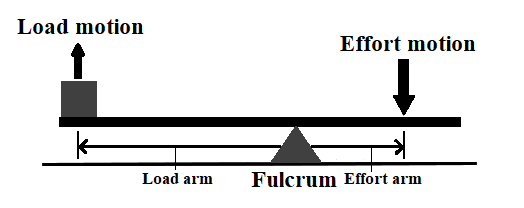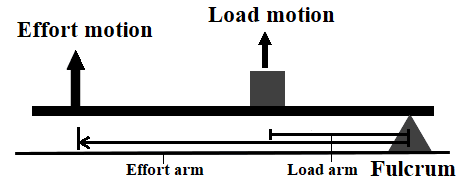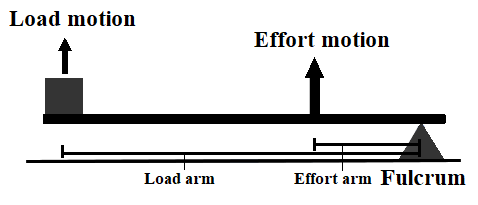
Types of lever in which effort is in between fulcrum (F) and its load (L).
A. Class I
B. Class II
C. Class III
D. All
Answer
575.4k+ views
Hint: A lever is used to amplify an input force in order to provide a greater output force, which is known to provide leverage. Levers are classified by the relative positions of the effort, the fulcrum, and the load. There are three classes of levers, according to the relative position of effort and load with respect to the fulcrum.
Complete step by step answer:
A lever is a simple machine consisting of a beam or rigid rod pivoted at a fixed hinge, called a fulcrum. A lever is a rigid body having the capability to rotate by a point situated on the machine itself. On the basis of the locations of load, effort, and fulcrum the lever is divided into three types. A lever is used to amplify an input force, given at the effort, in order to provide a greater output force, received at the load, which is known to provide leverage. The ratio of the output force to the input force is called the mechanical advantage of the lever.
Levers can be classified by the relative positions of the effort, fulcrum, and resistance, or load. We usually call the input force as the effort and the output force as the load or the resistance. This allows the identification of the three different classes of levers by the relative locations of the effort, the fulcrum, and the load.
Class I lever – Fulcrum situated between the effort and the load. In this case, the effort is applied on one side of the fulcrum and the load on the other side. For example: a crowbar, a seesaw, or a pair of scissors. Mechanical advantage can be greater than, less than, or equal to unity.

Class II lever – Load situated between the effort and the fulcrum. In this case, the effort is applied on one side of the load and the fulcrum is located on the other side. For example: a wheelbarrow, a nutcracker, or a bottle opener. The effort arm in this type of lever is greater than the load arm, and the mechanical advantage is always greater than one. It is also known as force multiplier lever.

Class III lever – Effort situated between the fulcrum and the load. In this case, the load is on one side of the effort and the fulcrum is located on the other side of the effort. For example: a pair of tweezers, a hammer, or the jaw. The load arm in this type of lever is greater than the effort arm and mechanical advantage is always less than one. It is also known as a speed multiplier lever.

The type of lever in which effort is in between fulcrum and its load is Class III lever.
So, the correct answer is “Option C”.
Note:
Levers are able to provide mechanical advantage that allows a small force to move a great weight. We can calculate this advantage by using the following simple proportion: the mechanical advantage is equal to the length of the effort arm divided by the length of the load arm. Since the effort and load arms are usually located on the same plane, we can easily calculate this mechanical advantage to ascertain how much the lifting force is multiplied. First-class levers are the simplest levers to conceptualize because of the simplicity in their design and of the levering action that allows them to work.
Complete step by step answer:
A lever is a simple machine consisting of a beam or rigid rod pivoted at a fixed hinge, called a fulcrum. A lever is a rigid body having the capability to rotate by a point situated on the machine itself. On the basis of the locations of load, effort, and fulcrum the lever is divided into three types. A lever is used to amplify an input force, given at the effort, in order to provide a greater output force, received at the load, which is known to provide leverage. The ratio of the output force to the input force is called the mechanical advantage of the lever.
Levers can be classified by the relative positions of the effort, fulcrum, and resistance, or load. We usually call the input force as the effort and the output force as the load or the resistance. This allows the identification of the three different classes of levers by the relative locations of the effort, the fulcrum, and the load.
Class I lever – Fulcrum situated between the effort and the load. In this case, the effort is applied on one side of the fulcrum and the load on the other side. For example: a crowbar, a seesaw, or a pair of scissors. Mechanical advantage can be greater than, less than, or equal to unity.

Class II lever – Load situated between the effort and the fulcrum. In this case, the effort is applied on one side of the load and the fulcrum is located on the other side. For example: a wheelbarrow, a nutcracker, or a bottle opener. The effort arm in this type of lever is greater than the load arm, and the mechanical advantage is always greater than one. It is also known as force multiplier lever.

Class III lever – Effort situated between the fulcrum and the load. In this case, the load is on one side of the effort and the fulcrum is located on the other side of the effort. For example: a pair of tweezers, a hammer, or the jaw. The load arm in this type of lever is greater than the effort arm and mechanical advantage is always less than one. It is also known as a speed multiplier lever.

The type of lever in which effort is in between fulcrum and its load is Class III lever.
So, the correct answer is “Option C”.
Note:
Levers are able to provide mechanical advantage that allows a small force to move a great weight. We can calculate this advantage by using the following simple proportion: the mechanical advantage is equal to the length of the effort arm divided by the length of the load arm. Since the effort and load arms are usually located on the same plane, we can easily calculate this mechanical advantage to ascertain how much the lifting force is multiplied. First-class levers are the simplest levers to conceptualize because of the simplicity in their design and of the levering action that allows them to work.
Recently Updated Pages
Master Class 12 Business Studies: Engaging Questions & Answers for Success

Master Class 12 Economics: Engaging Questions & Answers for Success

Master Class 12 English: Engaging Questions & Answers for Success

Master Class 12 Maths: Engaging Questions & Answers for Success

Master Class 12 Social Science: Engaging Questions & Answers for Success

Master Class 12 Chemistry: Engaging Questions & Answers for Success

Trending doubts
What are the major means of transport Explain each class 12 social science CBSE

Which are the Top 10 Largest Countries of the World?

Draw a labelled sketch of the human eye class 12 physics CBSE

How much time does it take to bleed after eating p class 12 biology CBSE

Explain sex determination in humans with line diag class 12 biology CBSE

Differentiate between homogeneous and heterogeneous class 12 chemistry CBSE




